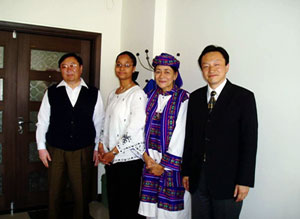Al-Alaq: The Clot

“And We sent not before thee any but men to whom We sent revelation–so ask the followers of the Reminder if you know not–With clear arguments and Scriptures. And We have revealed to thee the Reminder that thou mayest make clear to men that which has been revealed to them, and that haply they may reflect.” —Holy Qur’an, Surah 16, verses 43-44
The name I have given to this series of articles on the history of Genghis Khan denotes his cultural and genetic lineage to the people of Asia, Africa and the Americas. This subject is based upon the first revelation of the Holy Qur’an to Prophet Muhammad, may the peace and the blessing of Allah be upon him, titled Al-Alaq: The Clot. It is this clot of
genetic material that is associated with the birth of Genghis Khan who was noted to be born with an auspicious black blood clot in his right hand. Is there a spiritual connective link between his birth on the High Steppes of Central Asia to his destiny and the fulfillment of prophesies that fit into all the world’s great religions and societies?

According to National Geographic magazine’s cover story on Genghis Khan, December 1996, when Temujin is born in the 1160’s, Mongolia is a realm of perhaps 30 or so nomadic tribes with a total population between 1.5 million and three million. Roughly half are Turkic-speaking people who predate the Mongols themselves.
“The Secret History” chronicles offer a wealth of detail on Temujin’s rise to power. According to the article in National Geographic magazine, Larry Moses, professor at Indiana University, compares his early childhood experiences, which include the killing of his half brother, the death of his father and his childhood friendships to the Old Testament stories of David, Saul and Jonathan.
In Jack Wetherford’s book on Genghis Khan, we read further particulars on the early geneaology of Genghis Khan and his people in the following words which I quote from page 14: “In the 12th Century, dozens of tribes and clans lived on the Steppe as is characteristic of Nomadic people. Shifting combinations of all the Steppe tribe, the Mongol’s closest relatives were Tatars and Khitan to the east, the Manchus yet further to the east and the Turkic Tribe of Central Asia to the west. These three ethnic groups share a common, cultural and linguistic heritage with some of the tribes of Siberia where they possibly all originated. Located between the Tatars and the Turkic tribe with whom outsiders often confused them, the Mongols were often sometimes known as Blue Turks or as Black Tatars.
“As speakers of Altaic languages, named for the Al-Tai Mountain range in Western Mongolia, their languages bore a distinct similarity with Koreans and Japanese, but not with Chinese or the other languages of Asia. … The Mongols themselves claim a distinct identity from the Turkic and Tatar. They assert it then and now, a direct descent from the Huns who founded the first empire on the High Steppes in the third century. Hun is the Mongolian word for human being, and they called their Hun ancestors, Hun-Nu, the People of the Sun. In the fourth and fifth century, the Hun spread out from the Mongolian Steppes to conquer countries from India to Rome, but they were unable to sustain contact among the various clan and were quickly assimilated into the cultures they conquered.”

From the above material, I am reminded of Verse 13, of Surah 49, titled, Al-Hujurat: The Apartments wherein we read: “O, mankind, surely We have created you from a male and a female and made you tribes and families that you may know each other.
Then surely the noblest of you with Allah is the most dutiful of you. Surely Allah is Knowing, Aware.” In reviewing the history of Prophet Muhammad’s (PBUH) environment in the Arabian Peninsula, we find similar marauding caravans of tribes, clans and people who were constantly fighting with each other for survival.
They, too, were classified as Nomadic cultures disunited and quarrelsome at the time of the birth of Muhammad Ibn Abdullah who was destined by Allah’s decree to become the chosen Messenger or Prophet to first the disunited tribes and people of Arabia and its desert Steppes and then stretched from there in a short period of years to the surrounding areas, which included the Middle East, Africa, India, and other parts of Asia and Europe.
In the spreading out of the Mongol conquest, the Arabian Peninsula and North Africa, principally the Nile Valley, were never approached. This part of our globe contained the sacred land of our origin which was carried from there to Eurasia (Central Asia), and other parts of our world complex. We will note that the name Hun-Nu, referring to the human, is the earliest prehistory name for that part of Central Asia which connects to Siberia and ultimately forms a land bridge of travel from there into the America continent via the Bering Straits.
“Are they, then, who plan evil (plans), secure that Allah will not abase them in the earth, or that chastisement will not overtake them from whence they perceive not? Or that He will not seize them in their going to and fro, then they will not be able to escape? Or that He will not seize them with a gradual diminution? Your Lord is surely Compassionate, Merciful.” —Holy Qur’an, Surah 16, verses 45-47
To be continued.












